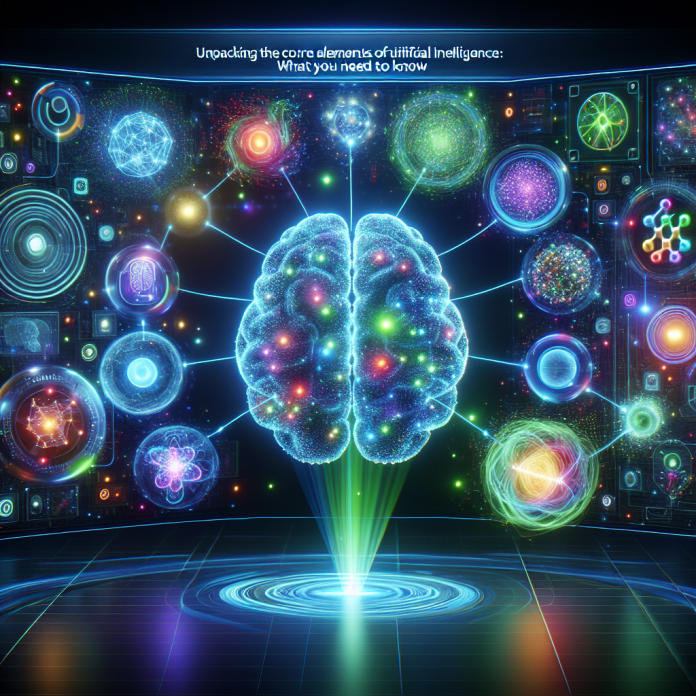The world of artificial intelligence (AI) is vast and ever-evolving, with new advancements being made every day. At the core of AI are certain elements that serve as the building blocks for creating intelligent systems that can perform tasks traditionally requiring human intelligence. These core elements are crucial in understanding how AI works and how it can be utilized in various industries.
### What are the Core Elements of AI?
When we talk about the core elements of AI, we are referring to the fundamental components that make up an AI system. These elements include algorithms, data, and computing power. Algorithms are the rules or instructions that govern how a computer program operates. In the case of AI, these algorithms are designed to mimic human intelligence by processing data and making decisions based on that data.
Data is another vital component of AI. Without data, AI systems would not have anything to process or learn from. Data can come in many forms, such as text, images, or audio. The more data an AI system has access to, the more accurate and intelligent it can become.
Lastly, computing power plays a crucial role in AI. The complex calculations and processing required by AI systems require significant computing power to operate efficiently. This is why high-performance computers and specialized hardware, such as GPUs, are often used in AI applications.
### How do these Core Elements Work Together?
To better understand how these core elements of AI work together, let’s consider an example of a self-driving car. In this scenario, the algorithms would be the rules and instructions that dictate how the car should navigate the road, detect obstacles, and make decisions in real-time.
The data collected by the car’s sensors, such as cameras and LIDAR, provide critical information about the car’s surroundings, including other vehicles, pedestrians, and road signs. This data is fed into the algorithms, which analyze it and make decisions on how the car should proceed.
The computing power of the car’s onboard computer processes this data and runs the algorithms to control the car’s steering, acceleration, and braking. By continuously collecting and processing data, the AI system in the self-driving car can learn and improve its driving abilities over time.
### Real-Life Examples of AI in Action
AI is not just a concept confined to science fiction movies; it is already making a significant impact in various industries. One such example is in the healthcare sector, where AI is being used to analyze medical images, diagnose diseases, and personalize treatment plans.
For instance, IBM’s Watson AI system has been trained to interpret medical images, such as X-rays and MRIs, to help doctors identify abnormalities and make more accurate diagnoses. By leveraging AI, healthcare providers can save time, reduce errors, and improve patient outcomes.
In the field of finance, AI is used to analyze vast amounts of data to predict market trends, detect fraudulent activities, and make investment decisions. Traders and financial institutions rely on AI-powered algorithms to make split-second decisions and maximize profits.
### Challenges and Ethical Considerations
While AI has the potential to revolutionize industries and improve our daily lives, it also presents challenges and ethical considerations that must be addressed. One of the main concerns surrounding AI is the potential for bias in algorithms.
AI systems learn from the data they are fed, which can sometimes be biased or incomplete. This can lead to discriminatory outcomes, especially in areas such as hiring, lending, and criminal justice. It is essential for developers to take steps to mitigate bias and ensure that AI systems are fair and transparent.
Privacy is another significant issue with AI, as these systems often rely on vast amounts of personal data to function effectively. There is a fine line between using data to improve AI algorithms and infringing on individuals’ privacy rights. Striking a balance between innovation and privacy protection is crucial in the development and deployment of AI technologies.
### The Future of AI
As AI continues to advance and become more integrated into our daily lives, the possibilities are endless. From autonomous vehicles to personalized healthcare, AI has the potential to transform industries and revolutionize the way we live and work.
However, it is essential for developers, policymakers, and society as a whole to consider the ethical implications of AI and work towards creating responsible and accountable AI systems. By addressing challenges such as bias, privacy, and transparency, we can harness the power of AI for the greater good and ensure a more equitable and sustainable future.
In conclusion, the core elements of AI – algorithms, data, and computing power – are the foundation of intelligent systems that are shaping the world around us. By understanding how these elements work together, we can unlock the full potential of AI and create a future where technology works in harmony with humanity.

